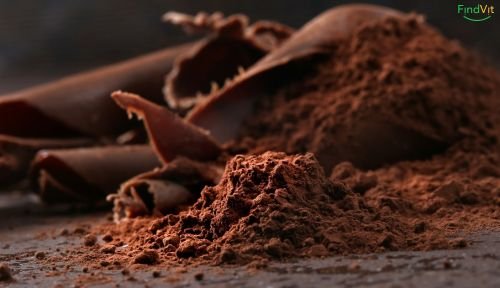The benefits of cocoa are an important topic in the field of wellness, which has a significant impact on the well-being and health of people. In many respects, cocoa beans and products made from them can be considered not only as delicacies, but also as valuable food sources with various beneficial properties. Since ancient times, the cacao tree has been considered the tree of life, and in our time, scientific research only confirms the benefits of cacao for the body, including its positive effects on heart health, mood, and even the prevention of certain diseases.1
In this article, we will discuss the history of cocoa and its cultural significance, provide some interesting facts about cocoa, examine the nutritional value and composition of cocoa, and take an in-depth look at the health benefits of cocoa. We'll also provide advice on how to choose a quality cocoa product and how to incorporate this nutritious ingredient into your daily diet, including practical tips for consuming cocoa. We hope that this information will help you better understand why cocoa should become an integral part of your diet.

The history and cultural significance of cocoa
The history of cacao is closely related to ancient civilizations, especially the Mayans and Aztecs. These civilizations considered cocoa sacred and used it both in religious rituals and as currency. The Mayans were the first to grow cacao trees in the territories of Mexico, and later the practice spread among the Aztecs. The Aztecs, for their part, valued cacao beans not only as food, but also as a powerful symbol associated with strength and endurance.
Mayans and Aztecs
In the Mayan and Aztec civilizations, cocoa was an integral part of their culture. The Mayans used cocoa beans not only as food, but also as a medicine. They believed that cacao had medicinal properties to help treat indigestion and lack of energy. The Aztecs, who lived in later periods, saw cacao as a luxury that only the nobility could afford.
Distribution of cocoa in Europe
Cocoa beans were brought to Europe by Spanish conquistadors in the 16th century. In the beginning, cocoa was only reserved for the nobility in Europe, but over time it became a popular drink among all walks of life. Europeans began experimenting with different cocoa drink recipes, adding sugar, cinnamon, and other spices that helped change the taste of cocoa and made it more popular.
These historical circumstances show how cocoa evolved from a sacred plant to a favorite drink that now enjoys worldwide popularity.

Interesting facts about cocoa
The cocoa we often buy as powder is actually cocoa nibs left over from the long process of processing cocoa beans, which includes drying, roasting, fermentation, crushing and grinding. This long processing often reduces the cocoa's beneficial properties. In addition, most store-bought cocoa is alkalized, further reducing its beneficial properties.
In Africa, where about 70% of the world's cocoa is grown, many farms still use unsustainable production practices. Farmers who grow cocoa cannot influence global market prices, so they often earn very little.
Cocoa contains not only caffeine, but also theobromine, which acts similarly to caffeine - it stimulates, gives energy, and improves mental activity. The type of cacao used in cacao ceremonies is different from regular cacao - it is more sour, bitter and has a more intense flavor. Drinking cocoa can help protect against viruses, stimulate emotions, improve memory, balance blood cholesterol and even protect the skin from sunlight.

Nutritional value and composition of cocoa
Cocoa beans are a source of various nutrients. It contains 11.5% of protein, 9.0% of cellulose, 7.5% of starch, 6.0% of biologically active substances, 5.0% of water, 2.6% of minerals and salts, including magnesium and iron, 2.0% of organic acids, 1 ,2% of theobromine and 1,0% of various sugars. In addition, cocoa contains Group B and E vitamins that are important for health.
Main components
The stearic acid in cocoa butter lowers total cholesterol in the blood, reducing bad (LDL) and increasing good (HDL) cholesterol. This type of fat also reduces the risk of thrombosis. In addition, cocoa is one of the foods with the highest magnesium content, which is essential for muscle health and proper sleep regulation.
Flavanoids and their specificity
Antioxidants in cocoa, especially flavonoids, protect cells from the harmful effects of free radicals. Flavonoids also improve blood circulation, reduce blood pressure and the risk of cardiovascular disease. Research shows that due to its antioxidant health effects, cocoa can slow down and even prevent cancerous processes, as well as have a positive effect on heart health and other age-related changes.

Health benefits of consuming cocoa
Strengthening immunity
The flavonoids in cocoa, especially the antioxidants, can help fight inflammation, reducing the risk of infection and boosting overall immunity. In addition, flavonoids act as natural antioxidants, protecting cells from the damaging effects of free radicals that can cause cell damage and disease.
Support for the heart and circulatory system
Cocoa extract is rich in flavanols, which help improve cardiovascular health. Studies show that consuming flavanols increases the production of nitric oxide, which helps arteries relax and dilate, improving blood flow and reducing high blood pressure. Regular consumption of cocoa can dramatically reduce the risk of cardiovascular disease, heart attack, and even death from heart disease.
Improving memory and cognitive functions
The flavonoids in cocoa beans also have a positive effect on brain function. Studies have shown that flavonoids can stop age-related memory loss and even restore it, especially in the elderly. In addition, regular consumption of these substances improves cerebral blood flow, which is important for maintaining cognitive health. Flavonoids accumulate in regions of the brain responsible for learning and memory, so they can improve memory, concentration and other cognitive functions.

How to choose quality cocoa
When choosing quality cocoa, it is important to pay attention to several essential aspects that will help you evaluate the naturalness and quality of the product.
Differences between natural and processed cocoa
Natural cacao, referred to as cacao, is less processed, retaining more natural antioxidants and minerals such as phosphorus, magnesium and iron. This cocoa is usually more bitter and intense. Meanwhile, processed cocoa, known as cocoa, is usually alkalized to reduce its acidity. This process not only changes the flavor of the cocoa, but also reduces the flavanol content by up to 60 percent, making the product less healthy.
The importance of reading labels
100% natural cocoa: This means that the product does not contain any additional additives or chemicals, which can be important for those who value naturalness and want to avoid unnecessary ingredients.
Non-genetically modified Criollo cocoa beans: The Criollo variety is one of the oldest and most prized varieties of cocoa, known for its flavor characteristics. Although genetically modified (GM) cocoa beans are not as widely distributed or used commercially as some other GM crops (such as soy or corn), some consumers may want to avoid any genetically modified food. It is important to mention that without accurate information, it is difficult to determine whether any cocoa beans on the market are genetically modified.
Certification marks: One of the most important aspects when choosing cocoa is certification marks such as Fairtrade, Rainforest Alliance, or UTZ Certified. These labels can ensure that cocoa beans have been grown sustainably and ethically, including labor rights and environmental protection.

How to include cocoa in your daily diet
Cocoa powder, due to its versatility and beneficial properties, can be included in various dishes and drinks. Here are some tips on how to do it:
Cocoa drink recipes
- Classic cocoa drink: To make a delicious cocoa drink, first add cocoa powder to a cup, add some warm milk or plant milk and mix well to a smooth paste. Then pour the remaining warm milk and mix. This method ensures that the cocoa powder is evenly distributed and the drink is delicious and thick.
- A spicy option: Mix 2 tablespoons of pure cocoa, a tablespoon of coconut oil, a little chili pepper powder, half a teaspoon of cinnamon, a few drops of natural vanilla extract and a tablespoon of honey into 0.5 l of warm milk. This drink will not only warm you up, but also give you energy.
Interesting ways to use cocoa powder
- Cocoa powder in porridges and yoghurts: You can spice up your regular morning porridge or yogurt by adding a teaspoon of cocoa powder. This will not only enrich the taste, but also increase the nutritional value of the dish by providing additional antioxidants and minerals.
- Chocolate pancakes: When preparing the pancake batter, add the cocoa powder to the dry ingredients. Cocoa will give pancakes not only a chocolate taste, but also useful substances. Bake the pancakes as usual and enjoy a healthier dessert.
These simple ideas will allow you to enjoy the benefits of cocoa every day and diversify your diet with delicious and healthy dishes.

Practical advice on cocoa consumption
The best time to consume cocoa
The cocoa drink should be combined with the personal rhythm of the day, taking into account the body's reaction to caffeine, which is a component of cocoa. According to research, it is best to drink cocoa when cortisol levels are low in the body to prevent anxiety and increase energy and mood stability. For example, if you wake up at 7 in the morning, it is best to drink cocoa between 9.30 and 11.30.
How to avoid overdose and adverse effects
Cocoa consumption should be moderate. Although cocoa is good for its antioxidants and minerals, too much of it can cause unwanted side effects such as anxiety or indigestion. It is recommended to avoid taking cocoa on an empty stomach and not to take it with coffee to avoid possible negative interactions. It is also important to choose quality cocoa, as processed products may have fewer beneficial properties.
FAQ: Health Benefits of Cocoa
Does cocoa improve heart health?
Yes, cocoa is rich in flavonoids that help boost heart health by lowering blood pressure and improving circulation.
Can consuming cocoa help control weight?
Cocoa can contribute to weight control due to its ability to reduce appetite and increase fat burning, but it is important to use it in moderation and in relation to total calorie intake.
How does cocoa affect mood?
Compounds in cocoa, such as theobromine and phenylethylamine, can help improve mood and reduce symptoms of depression.
Are there any health risks to cocoa?
Cocoa is safe for most people, but those with cocoa allergies or caffeine sensitivities should use caution.
Conclusion
In this article, we have revealed the health benefits of cocoa, the importance of including it in the diet, and tips on how to choose a high-quality product. Our discussion of cacao's history, nutritional value, fun facts, and health benefits not only provides a deeper understanding of this food, but also highlights its beneficial effects on heart health, memory, and overall immunity.
Incorporating cocoa into your daily diet is a commitment to health and wellness. The variety of uses makes it easy to diversify your diet, and choosing the highest quality cocoa products ensures that you get the maximum benefit. It is important to remember that balanced consumption and finding the middle ground is the key to long-term health and well-being, so the inclusion of cocoa in the diet should be considered and responsible.












2 comments
Simona Yes
Loved the tips on how to incorporate it into your daily diet. I recommended it to a friend
Willia M.
Cocoa is something that I usually remember only during the winter when I want something warm and cozy. But now, I realized that it is quite worth including it in the daily diet.